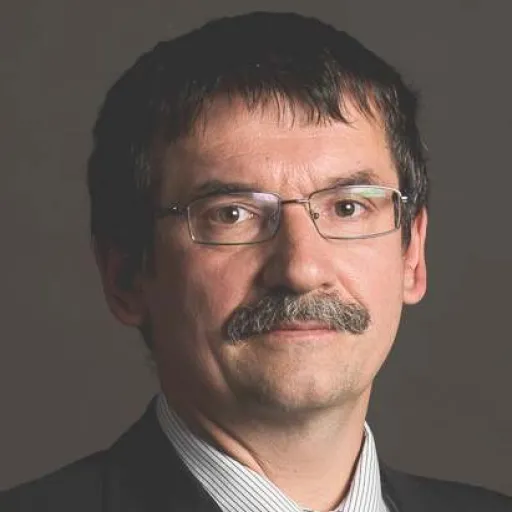
Ákos Zarándy, Doctor of HAS
Research advisor
Email
@email
Phone
+3612796131
Fax
+3612796196
Address
H-1111 Budapest, Kende u. 13-17.
Room number
K 330
Personal Information
Name: Ákos Zarándy
Year of birth: 1967
Workplace: HUN-REN Institute for Computer Science and Control (SZTAKI)
Address: POB: 63, 1518 Budapest, Hungary
Citizenship: Hungarian
Professional Experience
- 2023 Foundation of Holodetect Spin-off company
- 2015- Board of Roska Tamas Doctoral School (Pazmany Peter Catholic University)
- 2012- professor at Pazmany Peter Catholic University
main courses: Neural Networks, Embedded systems - 2011-present head of the Computational Optical Sensing and Processing Laboratory
- 2007-Senior Research Fellow (MTA-SZTAKI, Hungary)
- 2005-2006 CTO (Eutecus Inc. Berkeley, California, USA)
- 2000-2005 CEO (AnaLogic Computers Ltd, Budapest, Hungary, Spin-off company of SZTAKI)
- 1997-2005 Research Fellow (MTA-SZTAKI, Hungary)
- 1992-1997 PhD student (MTA-SZTAKI, Hungary)
- 1993, 95, 96, 98 Visiting scholar or post doc at University of California at Berkeley
Education
- 2010 DSC of the Hungarian Academy of Sciencies
- 1997 Ph.D. in Computer science, Hungarian Academy of Sciences:
"CNN Universal Machines: spatial logic, colors, and illusions" - 1992 MsC, Electrical Engineering, Technical University of Budapest, Hungary
Fields of interest
- Innovation, technology transfer
- Neural Network applications
- Camera based medical monitoring and diagnosis
- Holographic microscopy
- Focal-plane sensor-processors: architecture, design, and development
- Cellular Neural Network research: VLSI implementations, algorithm development
- IR imaging: sensor interface development
- Human and artificial vision, color vision: modelling
- Image processing: algorithms, embedded implementation
- System integration: ultra-high speed, low power, embedded image processing devices
Major technical achievements
- 2021- Digital Holographic microscope (Holodetect technology)
- 2019- Infant monitoring
- 2010-2012: Visual remote airplane detector device for UAVs for collision avoidance
- 2008-2009: Theoretical studies of many-core cellular processor arrays
- 2006-2007: 8x8 nanoantenna sensor interface including per pixel analogue amplifiers and programmable digital filters (100dB signal to noise ratio total) (Project Leader)
- 2005-2006: Focal-plane sensor-processor array with 64 fully programmable on-chip processors: XENON (Project Leader)
- 2004-2005: Locally adaptive image sensor development
- 2002-2005: Biologically motivated collision warning focal-plane sensor-processor array: LOCUST (Group Leader)
- 2002-2003 Bi-i: Industrial grade camera capable over 25,000 FPS visual decision making (capturing and real-time evaluation) Product of the year, Vision 2003, Stuttgart (Project Leader)
- 1996-2000: CNN Chip Prototyping System (chief developer)
Publication Summary
- 57 peer-reviewed published (or accepted) papers
- 1 edited book
- 1 book
- 12 Book chapters
- 68 conference contributions
- 1172 total number of citations (excluding self citation)
- 2 patents
Most Important International Collaborations
- 1994- 2015: Focal-plane sensor-processor chip development and testing, Microelectronic Institute Seville, Spain, Prof. Angel Rodriguez-Vazquez and his group
- 2002-2012 Active contour algorithm implementation on sensor-processor array School of Electrical and Electronic Engineering The University of Manchester, Dr. Piotr Dudek
- 2000-2006: Neuromorph modell implementations on sensor processor arrays Friedrich Miescher Institute, Dr. Botond Roska
- 1998-2003 Robot guidance algorithms for sensor-processor array Department of Electronic and Electrical Systems, University of Catania, Dr. Paolo Arena
Teaching
- 2005-present Pazmany Peter Catholic University, „Neural Networks, Embedded systems”
Grants and Scholarships
- 2005-2007: Nanoantenna sensor-processor array development: Eutecus Inc, Notre Dame University (two US grants: N00014-05C-0370 and HQ0006-05-C-7268, over $1,5M) role: PI
- 2002-2003 RobotEyepair (Hungarian grant IKTA4-044) Budget: 420k Euro. Role: PI
- 2004-2007 SPARK: Spatial-temporal Patterns for Action-oriented perception in Roving robots, (FP6-2003-IST-2) EU FP6, role: participant
- 2002-2005: LOCUST: Life-Like Object Detection For Collision Avoidance Using Spatio-Temporal Image Processing. (IST-2001-38097) EU FP5-FP6. Role: participant
- 2000-2003 DICTAM: Dynamic Image Computing Using Tera-Speed Analogic Visual Microprocessors. (IST-1999-19007) EU FP5. role: participant
Honors and Awards
- 2022 Kalman Rudolf Award
- 2007 Charles Simonyi Award
- 2007 Microprocessor Report Innovation Award, San Jose, California: Superfast Sensor-Processors Break New Ground in Digital Imaging
- 2005 Best paper award, “Per-pixel integration time controlled image sensor” ECCTD Ireland
- 2003 Product of the year at Stuttgart Vision fair: Bi-i camera
- 2002 John von Kemeny Award
- 2000 Denes Gabor Patent Award
- 1999 General Electrics Scholarship
Books
- 2016: Cellular Processor Arrays for Topographic Calculations: Architecture, Programming, Efficiency, and Implementability, Lambert Publishing
- 2011: Focal-Plane Sensor-Processor Chips, Springer, (Edited book)
Spcecial issues, sessions sessions
- 2004: Special issue: IEEE Transactions on Circuits and Systems—I: Fundamental Theory and Applications (TCAS-I), „CNN Technology and Active Wave Computing: Analog-and-logic cellular machines integrating sensors and/or actuators” guest co-editor
- 2003: Special session: IEEE International symphosium on Circuits and Systems (ISCAS) „Spatiotemporal cellular vision systems” co-organizer
- 2002: Journal of Circuits, Systems, and Computers, „CNN Technology and Visual Microprocessors”, guest co-editor